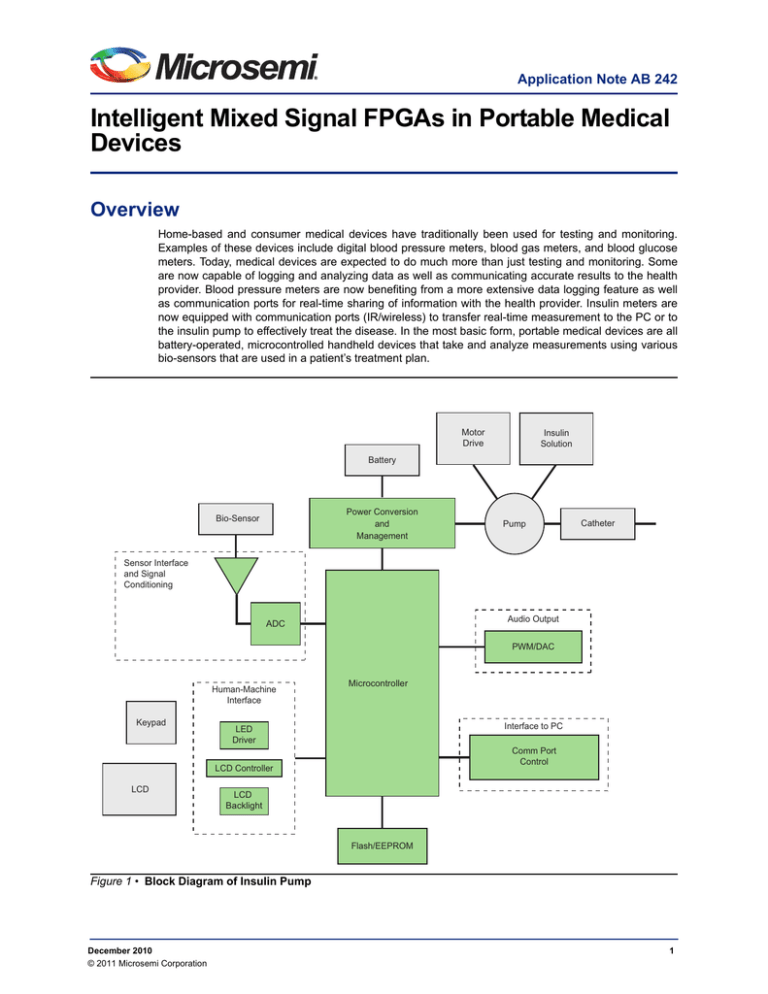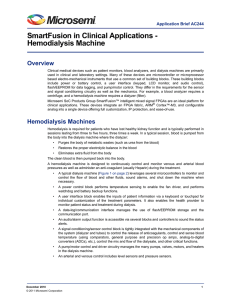
Application Note AB 242
Intelligent Mixed Signal FPGAs in Portable Medical
Devices
Overview
Home-based and consumer medical devices have traditionally been used for testing and monitoring.
Examples of these devices include digital blood pressure meters, blood gas meters, and blood glucose
meters. Today, medical devices are expected to do much more than just testing and monitoring. Some
are now capable of logging and analyzing data as well as communicating accurate results to the health
provider. Blood pressure meters are now benefiting from a more extensive data logging feature as well
as communication ports for real-time sharing of information with the health provider. Insulin meters are
now equipped with communication ports (IR/wireless) to transfer real-time measurement to the PC or to
the insulin pump to effectively treat the disease. In the most basic form, portable medical devices are all
battery-operated, microcontrolled handheld devices that take and analyze measurements using various
bio-sensors that are used in a patient’s treatment plan.
Motor
Drive
Insulin
Solution
Battery
Power Conversion
and
Management
Bio-Sensor
Pump
Catheter
Sensor Interface
and Signal
Conditioning
Audio Output
ADC
PWM/DAC
Human-Machine
Interface
Keypad
Microcontroller
Interface to PC
LED
Driver
Comm Port
Control
LCD Controller
LCD
LCD
Backlight
Flash/EEPROM
Figure 1 • Block Diagram of Insulin Pump
December 2010
© 2011 Microsemi Corporation
1
Intelligent Mixed Signal FPGAs in Portable Medical Devices
There are several functional blocks that are common to most portable home-based and consumer
medical devices:
•
Bio-sensor(s)
•
Amplification and analog-to-digital conversion of the sensor input
•
Power management: system power control and power sequencing
•
Microcontroller: low power operation and control
•
User interface: display
•
Human machine interface (HMI): keypads, scroll wheels, buttons, and switches
Additional requirements may drive needs for
•
Storage: interface to multiple standards
•
Interfaces: wireless and wired
•
Audio feedback or notification
A key design consideration for portable medical devices is low power consumption driven by the need for
extended battery life. Other requirements are faster time-to-market, low cost, reliability, small form
factors, and above all integration. Microsemi SoC Group SmartFusion™ intelligent mixed signal FPGAs
are the key in achieving these goals. The functional blocks in green in Figure 1 on page 1 represent
some of the functions that can be implemented in SmartFusion devices—the only devices that integrate
an FPGA fabric, ARM® Cortex™-M3, and configurable analog, offering full customization, IP protection,
and ease-of-use. Along with a microcontroller (MCU), FPGA fabric, and configurable analog,
SmartFusion FPGAs integrate substantial flash and SRAM memory plus comprehensive clock
generation and management circuitry. The SmartFusion architecture enables data storage and execution
of code from within a single monolithic device. Based on the proprietary flash process of the Microsemi
SoC Products Group, SmartFusion FPGAs deliver a true system-on-chip (SoC) solution that gives more
flexibility than traditional fixed-function microcontrollers.
SmartFusion FPGA’s as a Platform for Portable Medical
Devices
SmartFusion FPGAs combine all the features that designers of portable medical devices require into a
single chip, creating a true programmable SoC solution.
The Processor Core
At the heart of a SmartFusion device is an embedded ARM Cortex-M3 processor core. With its hardware
multiplier and divider, this 32-bit RISC processor delivers high performance: about 125 Dhrystone MIPS.
Surrounding the Cortex-M3 core are a number of integrated peripherals: SPI, I2C, and UART serial ports,
up to 512 KB of embedded FlashROM (EFROM), 10/100 Ethernet MAC, timers, phase-locked loops
(PLLs), oscillators, real-time counters (RTCs), and peripheral DMA controller (PDMA). The processor
and its peripherals are interconnected via a multi-layer advanced high-performance bus (AHB) matrix
(referred to as ABM). The ABM also provides the path for the processor and its peripherals to
communicate with both the FPGA fabric and embedded analog functions.
Programmable Analog
Portable medical designs must interface directly with various bio-sensors.The programmable analog
section or analog front-end (AFE) of a SmartFusion device contains the needed elements such as
analog-to-digital converters (ADCs) and digital-to-analog converters (DACs), along with more advanced
features.
Each SmartFusion device contains up to three 12-bit successive approximation register (SAR) ADCs,
capable of operating at 500 Ksps in 12 bit mode (550 ksps in 10-bit mode/ 600 ksps in 8-bit mode). To
process signals in the other direction, each device comes equipped with one first-order, sigma-delta DAC
per ADC, offering an effective 12 bits of resolution at 500 Ksps.
2
SmartFusion FPGA’s as a Platform for Portable Medical Devices
Further enhancing the functionality of the ADCs are up to five high-performance analog signal
conditioning blocks (SCBs) per device. Each SCB comes packed with two high-voltage bipolar monitors
(with 1% accuracy), a high-gain current monitor, a temperature monitor (with 0.25°C resolution), and two
high-speed comparators.
SmartFusion FPGA’s as a Platform for Portable Medical
Devices
SmartFusion FPGAs combine all the features that designers of portable medical devices require into a
single chip, creating a true programmable SoC solution.
The Processor Core
At the heart of a SmartFusion device is an embedded ARM Cortex-M3 processor core. With its hardware
multiplier and divider, this 32-bit RISC processor delivers high performance: about 125 Dhrystone MIPS.
Surrounding the Cortex-M3 core are a number of integrated peripherals: SPI, I2C, and UART serial ports,
up to 512 KB of embedded FlashROM (EFROM), 10/100 Ethernet MAC, timers, phase-locked loops
(PLLs), oscillators, real-time counters (RTCs), and peripheral DMA controller (PDMA). The processor
and its peripherals are interconnected via a multi-layer advanced high-performance bus (AHB) matrix
(referred to as ABM). The ABM also provides the path for the processor and its peripherals to
communicate with both the FPGA fabric and embedded analog functions.
Programmable Analog
Portable medical designs must interface directly with various bio-sensors.The programmable analog
section or analog front-end (AFE) of a SmartFusion device contains the needed elements such as
analog-to-digital converters (ADCs) and digital-to-analog converters (DACs), along with more advanced
features.
Each SmartFusion device contains up to three 12-bit successive approximation register (SAR) ADCs,
capable of operating at 500 Ksps in 12 bit mode (550 ksps in 10-bit mode/ 600 ksps in 8-bit mode). To
process signals in the other direction, each device comes equipped with one first-order, sigma-delta DAC
per ADC, offering an effective 12 bits of resolution at 500 Ksps.
Further enhancing the functionality of the ADCs are up to five high-performance analog signal
conditioning blocks (SCBs) per device. Each SCB comes packed with two high-voltage bipolar monitors
with 1% accuracy), a high-gain current monitor, a temperature monitor (with 0.25°C resolution), and two
high-speed comparators
3
Intelligent Mixed Signal FPGAs in Portable Medical Devices
Optional Off-Chip
Buffer
MCU
SDRAM
Frame
Buffer
Controller
LCD
Video
Timing
Generator
Enable/
Dim
Backlight
Power
SRAM for
Image
Buffer
Figure 2 • Simple LCD Controller
You can view design examples for keypad control, brightness control for white LEDs, color mixing for
RGB LEDs, and tone generation by the Microsemi SoC Products Group at
http://www.actel.com/products/solutions/hmi/dcard.aspx#examples.
Sensor Interface and Signal Conditioning
The implementation of each functional block in medical devices differs depending on features such as
sensing, processing, and information display demands of the device. Designers can choose from a
myriad of sensors to capture and measure physical quantities such as temperature, pressure,
brightness, position, speed, pH, gas concentration, level of chemicals in the blood, and time. These
sensors transform the measurement into voltage, current, frequency, capacitance, or some other
electrical quantity used for processing. Analog inputs from the above mentioned sensors can be
processed by the embedded SCBs in the SmartFusion FPGA, then they are passed to the embedded
ADC to translate the results to the digital domain for storage in the embedded SRAM blocks for further
processing by the embedded controller.
Power Management and Motor Control
Power management is key to any portable device, monitoring batteries, and for controlling which
peripherals are active at any given time. The SmartFusion mixed signal power manager (MPM) enables
designers to integrate intelligent configurable power management with their own Cortex-M3 firmware and
FPGA design using SmartFusion devices.
The SmartFusion MPM is capable of power-rail monitoring, power sequencing, closed-loop trimming,
power-up and power-down control, and event data logging for up to 32 individual power supplies. Many
portable medical devices need some sort of motor to either take samples or deliver therapy. SmartFusion
FPGAs are uniquely suited to active motor control for permanent magnet motors, servo motors, series
motors, separately excited motors, and alternating current induction motors.
A SmartFusion FPGA can actively manage multiple electric motors, including start and stop, control of
rotational direction, speed and torque, protection against motor overloads or faults, and active control
using closed loop performance algorithms.
4
Conclusion
Using the configurable analog available in SmartFusion FPGAs, the design can monitor motor
performance in real-time with or without dedicated encoders, applying corrective control signals to
maintain commanded direction, speed, torque and delivering precise motor position control.
Audio Output
Often a portable medical device needs to provide audio alerts, either to confirm data input, proper
operation, or as a warning of an error condition. A small piezo can be driven by a PWM block constructed
in the FPGA fabric or via one of the embedded DACs found in a SmartFusion FPGA.
Communication Interface
The ability to support multiple communication interface standards makes SmartFusion devices ideal for
portable electronics, offering the benefits of rapid development, fast time-to-market, and integration.
SmartFusion FPGA offer a wide range of embedded communication peripherals as a part of the
microcontroller subsystem. Included are multiple I2C interfaces, UARTs, and SPI ports, plus a 10/100
Ethernet MAC. If additional communication ports are needed, they can be implemented in the FPGA
fabric, using the your own design or a variety of communication IP cores from Microsemi’s SoC Products
Group and its partners.
Storage
Storage technology has made tremendous progress in the last decade. The rapid advances and ready
availability of small form-factor flash storage devices is driving the explosion of portable medical devices
in the market place. SoC Products Group offer storage solutions that cover most of the hard drives and
flash storage controllers for the portable market. As the storage device market proliferates, with ever
changing protocols and interface standards, design teams are challenged to shrink design cycle times
and yet create newer competing portable devices with additional features.
With the SmartFusion FPGA fabric, it is possible to implement a variety of storage functions without
having to redesign the whole system based on changing storage interface requirements. SoC Products
Group offers controllers for popular storage interface standards such as secure digital (SD), secure
digital input/output (SDIO), microSD, MultiMediaCard (MMC), and consumer election-AT(CE-ATA), that
are optimized for low power and suitable for the portable medical market.
Moreover, the SmartFusion microprocessor subsystem (MSS) contains an embedded external memory
controller (EMC) used to interface with off-chip memory devices that can be addressed by the MSS or
user logic in the FPGA fabric. The EMC provides a glueless interface to external memories, supporting
both asynchronous memories and synchronous SRAMs. Also available to the embedded Cortex-M3
processor is up to 512 KB of flash memory and 64 KB of local SRAM, plus up to 24 4,608-bit SRAM
blocks available in the FPGA fabric.
Microprocessor
Medical devices such as the insulin pump shown in Figure 1 on page 1 are typically controlled by a
microprocessor. These microprocessors perform various functions, such as processing data from biosensors, storing measurements, and analyzing results. SmartFusion FPGAs make a high-performance
32-bit RISC processor available to the application. The embedded ARM Cortex-M3 processor core
provides an unprecedented amount of processing power in a programmable device.
Conclusion
A well-designed, low power solution is an important part of portable medical devices. Clear displays,
responsive controls, reliability, and simple operation contribute to better health care, greater product
safety, and user satisfaction. SmartFusion FPGA, with its unique mix of a high-performance
microcontroller, dense FPGA fabric, and programmable analog-all in a single package-delivers the ideal
platform for these designs.
5
Microsemi Corporation (NASDAQ: MSCC) offers the industry’s most comprehensive portfolio of
semiconductor technology. Committed to solving the most critical system challenges, Microsemi’s
products include high-performance, high-reliability analog and RF devices, mixed signal integrated
circuits, FPGAs and customizable SoCs, and complete subsystems. Microsemi serves leading
system manufacturers around the world in the defense, security, aerospace, enterprise,
commercial, and industrial markets. Learn more at www.microsemi.com.
Microsemmi Corporate Headquarters
2381 Morse Avenue, Irvine, CA 92614
Phone: 949-221-7100·Fax: 949-756-0308
www.microsemi.com
© 2011 Microsemi Corporation. All rights reserved. Microsemi and the Microsemi logo are trademarks of Microsemi
Corporation. All other trademarks and service marks are the property of their respective owners.
51900177-1/12.10





